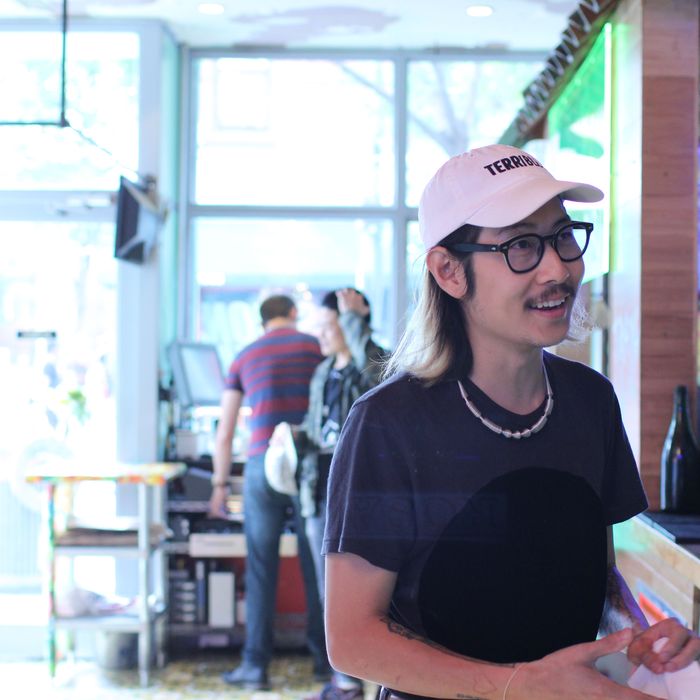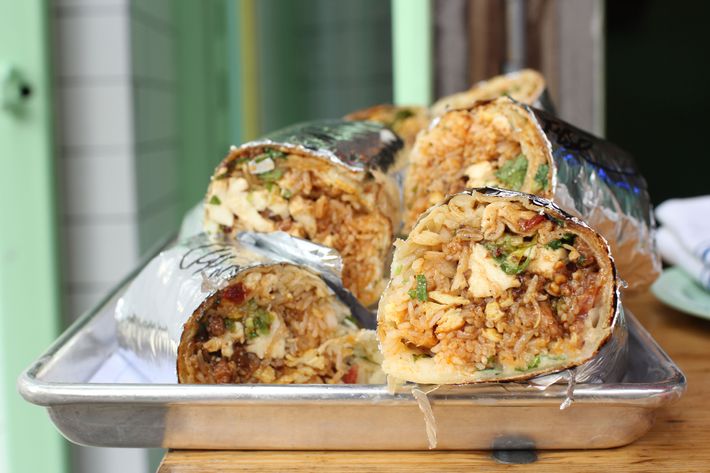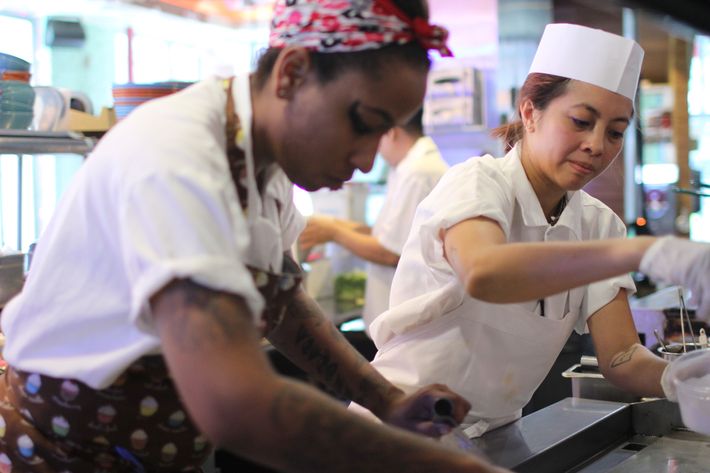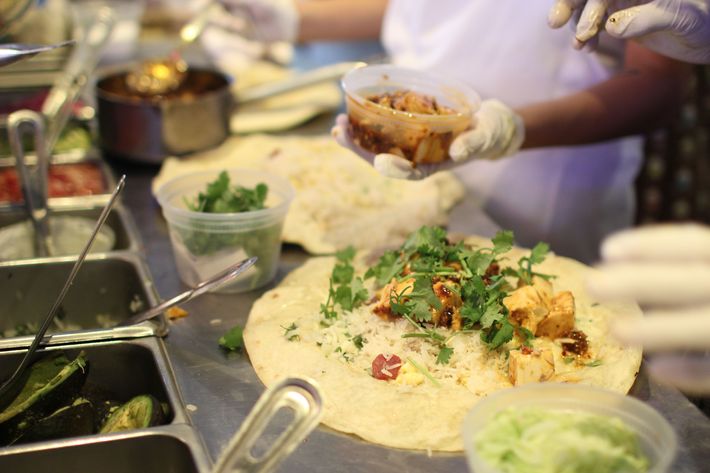
SinceMission Cantinaopened in November of 2013, Danny Bowien has changed the menu and the concept almost constantly: He has served ambitious dishes likebeef-heart ceviche and scrambled eggs with sea urchin, tacos atop tortillas made throughnixtamalizing Anson Mills corn, aTacoSupreme, excellentchicken wingsand rotisserie chicken,烤干酪辣味玉米片,Vietnamese breakfastand other Asian-inspired dishes, and, most recently, theFuku Finger Crunchy Wrap, a collaboration with David Chang.
It’s safe to say that, as the gonzo-Mexican theme slowly went by the wayside, Bowien lost his way. But one thing did remain a constant: Bowien knew that he had created atruly showstopping burrito. In fact, he had initially launched Mission Cantina as a burrito pop-up. It took him almost two years to get back to where he started, but Bowien has decided, after a great deal of thought, to transform Mission Cantina into a burrito-only restaurant. And, to commemorate the shift, he’s unleashing a newMission Chinese Foodburrito that includes mapo tofu, salt-cod fried rice with Chinese sausage, and chili vinegar, rolled up in a griddled flour tortilla, for $14.
Bowien is now, of course, one of many chefs to recently give a full embrace to the “fast-casual” movement: He’s following the lead of David Chang, who’s quickly scaling upFuku, and Roy Choi and Daniel Patterson, who are about to openLoco’l. And New York’sBrooks Headley just earned twoTimesstarsfor his tinySuperiority Burgershop. The prevailing message is that, these days, major chefs want their ownShake Shacks. One look atShake Shack’s blockbuster IPOmakes the appeal abundantly clear, but, as it turns out, there are difficult trade-offs that chefs must make when they embrace this model. Grub sat down with Bowien to discuss the balance between being both critically and financially successful, the trappings of having too much creative freedom, and why he believes he was running Cantina incorrectly.
I remember when you first started making burritos, you insisted that you wanted them to be takeout-only. It seemed like, creatively, you didn’t want to be pigeonholed.
When we opened Mission Chinese in San Francisco, we weren’t under any microscope. No one was paying attention to us. So it was very much like a band making its first album. There’s no pressure. You’re just doing what you want to do. When we came to New York, we had the same mind-set. People were saying, “Oh, Mission Chinese Food,” but it wasn’t that big of a deal. But with the opening of Mission Cantina, even putting aside that New York’s Chinese closed, there was a ton of pressure. And we were riding this high, and we were like, “We’re just going to do what we want, and we’re going to open, like, a San Francisco burrito shop.” No shame. I thought it was the one thing that’s been missing here, in my opinion.
Chinese closed, and then I don’t know what happened. That’s the problem with having a lot of creative freedom: Sometimes you take it in a direction that you don’t know that you need to go. So I feel like Cantina was, in the beginning, that experimental album that I wanted to get out of my system. But thinking back to it now, it evolved so much because until Chinese reopened, I had something in me that was like, “I have to prove something” — not to everyone else, but to myself. I think after Chinese reopened, it was just about taking a deep breath and looking back and being like, “What do people want?”
I talked to Angela [Dimayuga, Mission Chinese’s executive chef] a lot about it. What is Cantina’s version of the bacon rice cakes? The mapo tofu? We were able to get a lot of stuff out of our system and make amazing tortillas, but it got to a point where Angela looked at me one day and said, “You’re a chef. I owe this to you because I want to tell you, as a consumer, people in New York want a constant. They want to know that they’re going to be able to go somewhere and get this thing. You’ve changed it so many times, and it’s not a pop-up, so you alienate your customer base.” Basically, I was just running a business incorrectly.
Even at restaurants likeEstela, part of the success is that you know you’re going to order the beef tartare, or the ricotta gnocchi, every time.
对了,你知道你会得到什么。对我来说,I was trying to create those dishes, but what were they? I made the tortillas, and (a) everyone else is doing that, and (b) Angela’s like, “It’s just right in front of you. You’ve been running away from this burrito thing.” It was like our Momofuku pork bun — not as big as that, but it was like a thing where you’re like, “Yeah, I get it. It’s great. Everyone loves that, but I’m creative and I wanted to do this other thing.”
It’s also a control, thing, too: You dictated the burrito terms so it was a takeout-only item and only available at a certain time.
One day this light went off and I was like, “We should just turn this into what it should have been all along, and that’s a burrito shop.” That’s what I wanted. I was just struggling with what would make me happy. And Angela said, “What would make you happy is if all the customers were happy.” And so that was that. People were like, “You should have a big relaunch. Close it for a few days and reopen,” and I was like, “No, I don’t want to do that. Let’s just change it over quietly.” And we’ve been a burrito shop for, like, two months now. From a business perspective, it makes a lot more sense and a lot more money.
Let’s talk about that: It’s tough to strike a balance between being critically and financially successful, especially in New York
The metrics of running restaurants in New York, especially, are insane. You can come eat at Cantina for $13.50, and it’s a full meal. This is definitely the lowest it can be without losing money. Our check average is lower. I think that’s where the Fukus and the Superiority Burgers and the Shake Shacks win because it’s like, is this a fast-food restaurant? Yes. That’s what we need there. The good thing about New York is that there’s room for everything.
You also want to try to ensure that whatever you create is set up to last.
I think it’s also about coming to terms with the fact that it’s a business, and you do have to run it like a business. You have to be smart. Will my experimental Mexican version of Estela or whatever else be around in five years? Probably not. I have other things that I’m going to be doing. It’s just having that one constant there and then being able to build on that.

How will this shift impact the look and the vibe of Cantina?
It totally reminds me now of the old Mission Chinese. It’s scrappy. We’re about to put a TV in there. I really want to, like, disarm people’s expectation levels, or maybe fulfill their expectations. It’s a Mexican restaurant. It’s a burrito restaurant. It has a free salsa bar. We’re really just making it into a place where people can hang out.
Any chance you’ll ever revive the Vietnamese breakfast?
We were doing Vietnamese breakfast because it’s something I love, and there is a void. That’s all I ate for breakfast in San Francisco. I made pho for breakfast today. But we did that and no one came, and then you close it and everyone wants to come. Things are cyclical in New York. I’m understanding New York more now. But we want to do that again eventually, maybe during different hours. I think the hours were tough for people.
为什么你那么sistant to making that more accessible?
The problem with us before was that we were so governing. I think that when I first came to New York I was like, “You’ve got to give New Yorkers what they want, and you can’t say no,” and the problem with me at Cantina was I was saying no a lot: “No, you can only have the burritos for takeout or delivery. You can’t eat them here.” And I don’t know what the fuck was happening. I think I was just under a lot of pressure. I was a crazy person trying to open Mission Chinese. Three restaurants in two years in Manhattan is really insane.
When things are crazy, I understand the desire to exert that sense of control.
是的,这是疯狂的。我把很多的局限性myself, like not eating meat and not drinking. With the Vietnamese breakfast, we’re wondering how can we bring that back in a context that people know they can get it, and when they can get it, and that it’s not impossible. So I think we’re toying around with making that available. December, hopefully, we’ll be able to do that again.
Do you see yourself scaling Cantina and opening several burrito shops?
We’ve been approached about that a lot. I just feel like, it’s a “crawl, walk, run” thing. I think that we’re now walking, and I don’t want to run. It’s a very scalable thing, but I want to be able to manage the shops. I look at all these other people: I don’t know how Alex Stupak does it. And Chang. I just wanted to be able to organically evolve. Three years ago I moved to New York, and I was like, “I want to open restaurants in Paris and Oklahoma,” and then I realized very quickly that you have to be at your spots. Or it takes time to not be in your spots.
How much are you in the kitchen these days?
A lot. Mission Chinese is changing over to the fall menu. I work every morning at Cantina. I work seven days. Again, I think it gets to a point — where is your energy best spent? I also live around the corner from Cantina, so that helps. But yeah, seven days. Mission Chinese is open seven days now, so it’s pretty nuts.

It seems like part of the appeal of the fast-casual model is that someone like you could step back and not be sweating in the kitchen daily.
你看到的是厨师布局概念that they can run and manage. If you look at the technology in fine dining or just nice restaurants, all we’re chasing after is consistency. That’s whysous-videwas so popular for so long, because it was kind of un-fuckable. This was in Chang’s book: You know your line cook’s not going to fuck up this beautiful piece of steak. Chefs are also realizing now that maybe people don’t want to eat 30 of your creations. Maybe they want to eat one really good one that’s cheap and affordable. That’s sustainability. Look at it from that perspective and it’s like,Okay, let me just really put a lot of hard work into this thing and then run with it.
Did getting critical acclaim for Mission Chinese help?
Yeah. It’s just a lot about ego and losing your ego. Why am I doing this? Who really cares? Am I making a difference? Am I not making a difference? It’s a very “small fish, big pond” situation, and I feel like our profession is still, as blown up as it’s getting, it’s still a very blue-collar profession. You’re cooking for people.
Again, I’ll have my slice of humble pie happily and say, “Look, you’re not going to be able to nail it every single time like the Torrisi guys.” They have a Midas touch, and there’s a reason for that because they’re awesome and they’ve taken their time. For me, I had to be like, “Well, what works? And what is sustainable for me?” You can’t be changing people’s lives forever. You can also just have a good restaurant. It doesn’t have to be, like, the best restaurant in the world. When we got into this I wasn’t like, “I’ve got to be No. 1 on every list. I’ve got to make it a Michelin-starred place.” I think there was even a silly time at Mission Chinese where I said in an interview, “You know, I don’t ever really want to open a real restaurant.” And then here I am.
And then you end up as part of this eliteGrand Gelinaz!group,cooking at Noma.
It’s just so funny how things can change. I was in Cantina today and I was like, “How did I get all the way over here?” I was searching so hard for how I could I make this as good as Chinese, and then I realized that it doesn’t have to be as good. It can be its own thing. There’s room for everything, again.
How do you define success?
All I really want is for people to come in and leave happier than they were when they came in, and not spend a ton of money. That’s not really a hard thing to do. It just took me a long time to realize that that’s what I actually need to do again.
You’reclose friendswith a lot of talented, entrepreneurial chefs. Do you think, in part, that got in the way of your decision to simplify the Cantina menu? Are you competitive?
No, it wasn’t ever competitive, or me being like, “I don’t want to be compared to Stupak,” or anything like that. I think the biggest thing for me was none of those people were coming into the restaurant. Cantina needed to be a place where I could go and my cooks and chef friends would come to on their days off. My friends just weren’t coming in, and maybe it was because it didn’t feel right. Now you can feel that we’re happy.
I didn’t get nervous. I didn’t think I had to ramp it up. I mean, maybe I did. Maybe subconsciously. Like when Enrique [Olvera] came in, and I’m sitting there talking to, like, the god of Mexican cuisine. I was clearly not going to compete with that, so let’s not even try. Stupak’s pedigree is insane. Clearly not competing against that. I didn’t even offer al pastor tacos on the menu. I was like, “I’m not even going to do that because he can do it and way better.” I guess in a way, maybe, that did actually kind of carve out this decision that I’ve come to. I want to be a part of that conversation, but I also want to be part of our own conversation. It’s just taken a long time to come to that realization, that you don’t have to be like everyone else.
I can’t tell you how many times people are like, “Oh, why don’t you just turn this into another Mission Chinese?” I’m sure people say that to Dave [Chang] all the time: “Why don’t you just open another Noodle Bar?” I guess it’s the ego thing, and also the desire to have creative outlets.
The magic is often lost if you open multiple locations or move to a bigger space.
It’s the curse of being successful. You can never live up to the hype. For the longest time we were trying to live up to the hype, but you just can’t. It’s impossible. Unless you’re a Torrisi.
Well, Mission Chinese is a real triumph because the food got even better, and it didn’t totally lose its DNA.
For Mission Chinese, there was no other option. But I think it lost a little of its DNA. It lost a little of the sense of being a party. We had to grow up a little bit. I think that’s just a sign of growing at a very accelerated rate in New York. New York kicks your ass and makes you either survive and thrive or just fail, you know? There was an insane amount of expectation on that restaurant, and now that’s out of the way, now that we’ve had our failures in that way, I’ve been able to think clearer and be like,Okay, what’s the next Mission Chinese going to be like? What are we going to do with Cantina? What is the next Cantina going to be like? Do I want to open more restaurants in New York?
Do you?
是的,但是我不想打开任何更多的餐厅that get reviewed — I mean, it’s hard to say because everyone’s getting reviewed. I think that the days of chefs being like, “I’m only going to put pig’s feet and tripe and whatever else on the menu,” are waning. In New York especially, people are either going to get what they want from you or they’re going to get it somewhere else, and that’s the bigger conversation here. Yes, we want to open more spots, but they have to be different than what we’ve done before.
Let’s talk about the Mission Chinese burrito, with mapo tofu.
It will rotate monthly and be available for delivery. The Fuku Crunchy Chicken Wrap thing is not available for delivery or takeout yet, but it will be because we just have to make sure we can make enough for people who come to the restaurant.

How much pressure is there to keep creating an attention-grabbing new item? Does it start to feel like a schtick?
With Mission Cantina in the beginning there was that pressure, and it’s impossible to keep up with. We’re not going to have the new hot thing forever, and we just have to be okay with that. It can’t be “How many iconic dishes can we pump out?” I think whenever you chase after that … It has to come organically. Dominique Ansel is a great example. The Cronut is insane, right? Crazy phenomenon. No one pays attention to the fact that all of his other shit is amazing, too, and he’s an amazing chef.
But sometimes I see him doing yet another hybrid dessert and I think,Do less. I’m sure the attention is addictive.
For us this is definitely not a publicity thing. It’s just something that we’ve wanted. We just wanted to make this thing because you can’t get Mission Chinese for lunch, and it makes sense. If you think about great songwriters, there’s this guy Max Martin, or whatever his name is, that wrote like every Backstreet Boys and ‘N Sync and Britney Spears hit back in the day, right? There’s only one of that guy. Not all chefs are just creative geniuses. It takes a long time.
In the the age of Instagramming food and having dishes go viral, many chefs try to force it.
Exactly. So many people just want to come and take a picture of whatever the thing is. When Cantina opened, people were coming by, taking a picture, and then not even eating. But I guess now there’s not any pressure anymore. That was the mistake I made was chasing after that, and then getting so sidetracked. People like you for you, hopefully. You like a band because you like their music. Chasing after that hit thing all the time — you pick up on that. People pick up on that.
Or they just become tired of you.
有一个饱和点。多少次,do you want to hear about me or Mission Chinese? In the past couple of years I’ve come to the realization point that the most successful people that you see surround themselves with smart people. In a sense, they’re not passing the torch, but they’re giving up some responsibilities and power. With the Mission Burrito, it’s just coming from an honest, good place — not a place where we’re trying to be Mission Chinese anymore.





